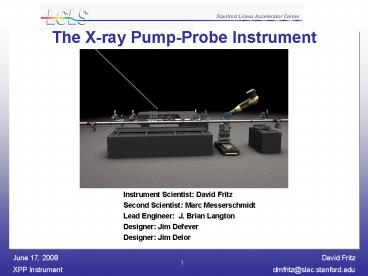The X-ray Pump-Probe Instrument PowerPoint PPT Presentation
1 / 22
Title: The X-ray Pump-Probe Instrument
1
The X-ray Pump-Probe Instrument
Instrument Scientist David Fritz Second
Scientist Marc Messerschmidt Lead Engineer J.
Brian Langton Designer Jim Defever Designer Jim
Delor
2
Outline
- Brief Instrument Overview
- Sample Goniometer System
- Detector Mover System
- Optics Table Design
- Conclusion
3
XPP Experimental Techniques
- Time-Resolved X-ray Diffraction (TRXD)
- Time-Resolve Diffuse Scattering (TRDS)
- Time-Resolved Protein Crystallography (TRPX)
- X-ray Emission Spectroscopy (XES)
- Small Angle X-ray Scattering (SAXS)
- Optical Probing of X-ray Transients
- The instrument budget is not sufficient to
provide capability to all techniques
4
XPP Instrumentation Categories
- X-ray Beam
- Preparation (spatial profile, intensity,
spectrum, repetition rate) - Delivery to sample
- Characterization (spatial profile, intensity,
arrival time) - Optical Beam
- Creation
- Preparation (spatial profile, intensity,
spectrum, repetition rate, temporal profile) - Delivery to sample
- Characterization (spatial profile, intensity,
spectrum, temporal profile) - Sample Environment
- Orientation Positioning
- X-ray Detection
5
Instrument Block Diagram
6
XPP Instrument Location
Near Experimental Hall
X-ray Transport Tunnel
AMO (LCLS)
XPP Endstation
XCS
CXI
Far Experimental Hall
7
Instrument Layout Plan View
8
Detector Mover Design Goals
- Flexibility to accommodate a wide variety of
sample environments - Capable of orienting small samples ( 50 µm) over
a wide range of reciprocal space - Sphere of confusion lt 30µm
- Open access to allow close proximity laser optics
- No interference with direct beamline while in
monochromatic mode
9
Sample Goniometer Tilt Platform
- 400 mm x 400 mm top surface
- 5angular range of arc segments
- Large load capacity (gtgt 50 kg)
- 200 mm working distance
10
Sample Goniometer Tilt Platform (2)
11
Sample Goniometer Kappa Configuration
12
Detector Mover Design Goals
- Operate in both interaction points
- 10 cm 100 cm sample to detector distance in
forward-scattering upper hemisphere quadrant - 10 cm 50 cm sample to detector distance in
back-scattering upper hemisphere quadrant - Repeatable position the XPP detector pixels to a
fraction of the pixel size - Definitively know the position of all detector
pixels to a fraction of the pixel size
13
Detector Mover Coordinate System
14
Detector Mover Coverage Requirements
15
Detector Mover Concept
- 6-axis Industrial Robot
- Load capacity (gt 20 kg)
- 50 µm repeatability
- Floor or ceiling mountable
- No counterweights
- Remotely variable sample to detector distance
- Remote control of detector clocking angle
16
Detector Mover Path Forward
- Engineering and manufacturing will be broken up
into 3 work packages - Statement of work 1
- Verify that a industrial robot has the capability
of meeting motion requirements - Statement of work 2
- Create a concept for integrating robot into the
XPP instrument - Statement of work 3
- Manufacturer, install, test and integrate system
17
Detector Mover SOW 1
Test 1
- Test 1 Spherical motion and pointing
- System is capable of moving the detector about a
spherical surface of a user defined radii while
pointing the detector at the interaction region - Test 2 Repeatability
- Measure repeatability and hysterisis of system
- Test 3 Detector Clocking Angle
- Measure how well the clocking angle can be
controlled - Test 4 Stability
- Measure long term ( hours) motion drift for
various fixed positions
Test 2
18
Detector Mover SOW 2
- Concept for integrating system into XPP
- Robot arm mounting
- Reach requirements can be met without intruding
into mechanical stay clear zones - Safety system
19
Optics Support Table Design Goals
- Repeatable position optics in two operating
positions (mono, direct) - Initial beam based alignment is expected for each
position but the desire is to have a
configuration file loaded for each operating mode
without the need for alignment - Stably support X-ray optics and diagnostics
- Design logic
- Optical axis will be defined by XPP slits
- X-ray optics and interaction point can drift
together on the order of 100 µm with minimal
impact - However, the diffractometer thermal drift is an
unknown - It was determined that it was best to design a
support table that fixes the position and
alignment of the optical elements to the highest
extent reasonably achievable - This reduces misalignment issues to a one
dimensional problem - Design goals in priority order
- Stability of optics with respect to each other
over short and long term periods - Absolute position stability
- Slits are the gold standard and need to be the
most stable of all elements
20
Optics Support Table Case Studies
- Analyzed component displacement due to bowing of
support structure for a 2 F temp change - Analyzed global displacement of entire structure
due to 2 F thermal expansion - Large granite surface plate with a low profile
strongback was best option - Themalization time constant of the granite is
many days - However, the drawback is the rigging effort
must be moved in through the FEH
21
Optics Support Table Design
- Strongback has been split into two sections to
minimize bowing and to prevent system
overconstraints - Strongback is strategically tied down to rails
near locations of slits
22
Questions for the Committee
- Is the sample goniometer design optimized form
the scientific goals of the instrument? - Are the sample mover design requirements
reasonable? - Does the sample mover path forward seem
reasonable? - Is the design logic of the optics support table
valid? - Any other concerns/comments?

